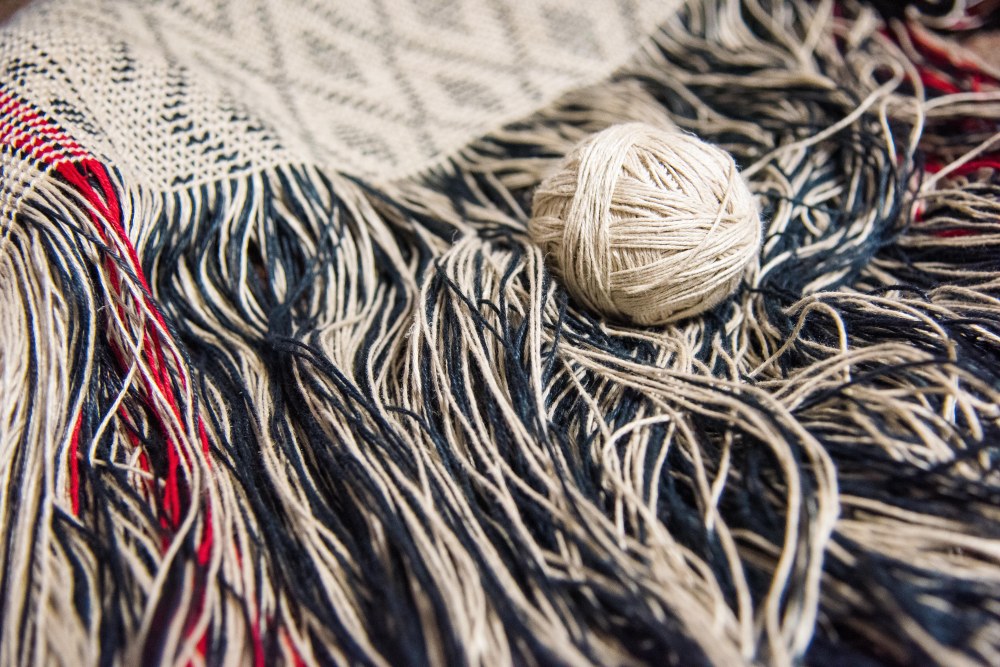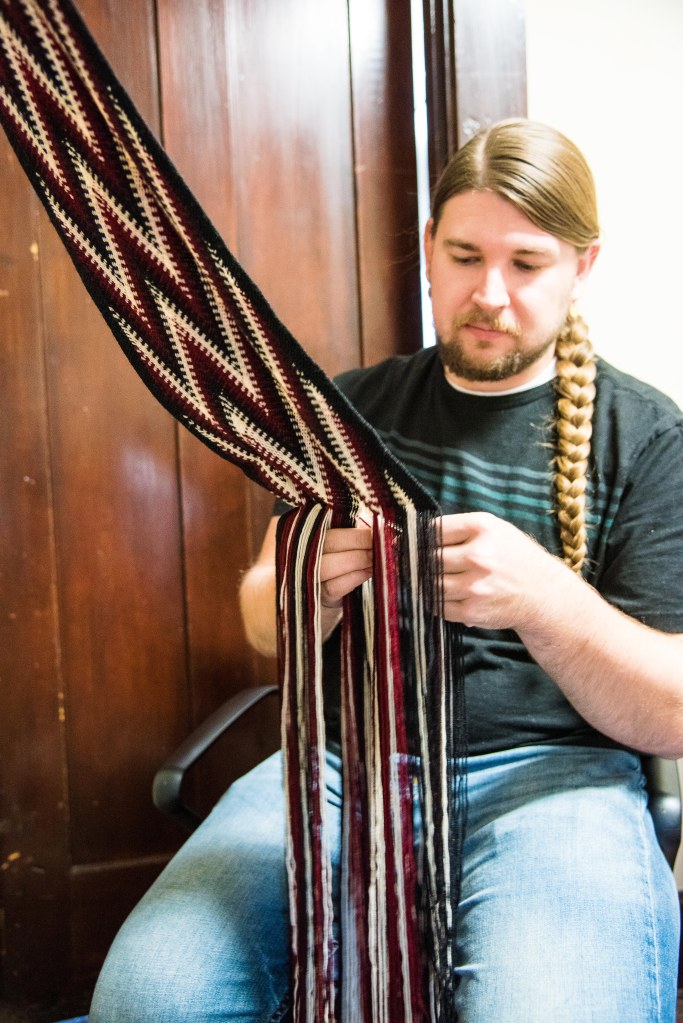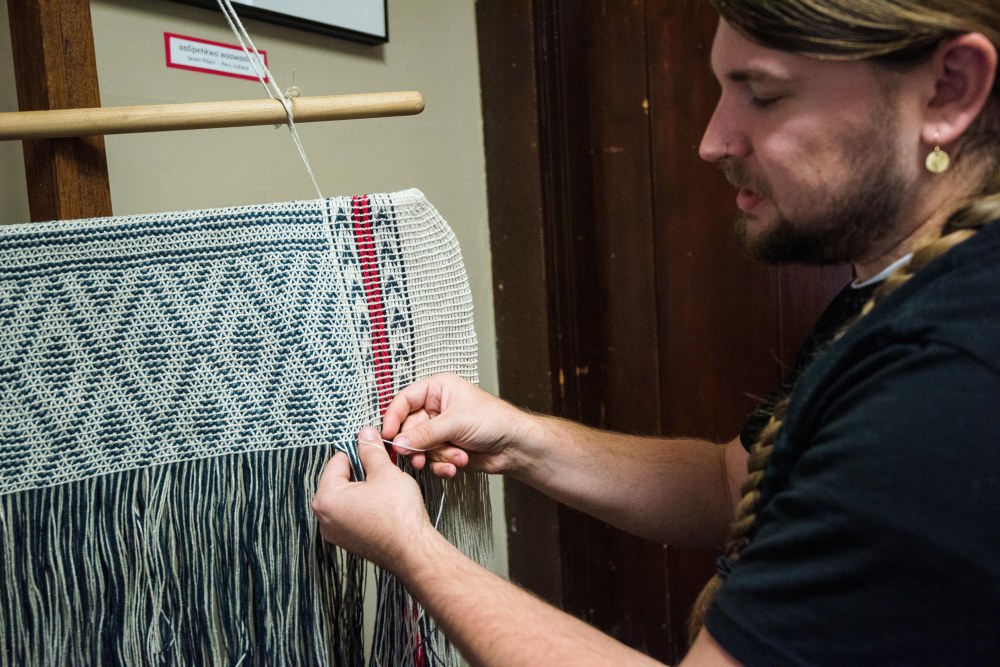Written by Joshua Sutterfield
Meet Jared Nally, a Myaamia student who is currently seeking a Master’s degree in Environmental Science at Miami University. He is a recipient of the Aanchtaakia Graduate Fellowship. Aanchtaakia is the Myaamia word meaning ‘change maker.’ This fellowship is specifically designed for tribal scholars motivated to make positive change in tribal communities and to share their research or interests on Miami University’s campus. Jared is a talented weaver and sees his craft as a connection to his community. I was fortunate to be able to spend some time with Jared and conduct an extensive interview. As you will see below he sees his craft as a doorway to giving back to the community and adding to the ongoing revitalization of our cultural ways.
Joshua: Tell us who you are.
Jared: aya ceeki ahsapa neehi Jared weenswiaani. I grew up in Kansas, and I’m a descendant of the DeRome family. I grew up outside of the Oklahoma and Indiana Myaamia communities, but was called back to the Myaamia community in my 20s. I am a weaver.
Joshua: How would you describe yourself as an artist? What is your aesthetic and what’s your favorite medium to work with?
Jared: I don’t really call myself an artist, although I do get called that by others. I guess the easy part of that question is “what medium I like to work with” — I like textiles. It’s part of why I don’t consider myself an artist. The utility and aesthetic of textiles goes hand in hand, and I view that differently from art. I like that about a lot of our cultural objects. Somebody took the time to make things that were useful and they also spent the time to incorporate a Myaamia aesthetic into them. That’s what I think I do when I create my pieces. They’re always an item that has purpose or use, and inherently, by craft, they turn into something beautiful. So, I don’t necessarily think of what I make as art. Not to corner Myaamia people into having to always make something useful to use Myaamia aesthetics, because we don’t always do that. But, I like the ability to do that in my work.
Joshua: When did you first start weaving?
Jared: I think the story that you’ll want to start with is the background of how I grew up. I didn’t grow up in a Myaamia space. After I graduated high school and became an adult, I started to figure out my hobbies and interests. Knitting was one of the first, and knitting led to weaving and then to spinning. I accrued skills that were deeply embedded in culture. There’s a lot of cultural traditions just within knitting. I knew about my Myaamia heritage, but I hadn’t connected with it, and I saw textiles as a way to connect with my Myaamia community and culture. It was that idea, in combination with reading our tribal newspaper, that made me feel comfortable reaching out and attending my first national gathering where I was able to meet people in our community and start to learn about some of our textile traditions.
When I first started talking to people in our community, they talked about our language being spoken again and how we were in a time of re-awakening. People were getting called back to the community. So I consider textiles and weaving to be a gift that allowed me to come back to the community.
Joshua: Do you remember the first piece you ever made? The first weaving piece.
Jared: Myaamia weaving?
Joshua: How about both? Do you remember the first piece you ever weaved?
Jared: Yes. And it’s a two-part answer. In grade school, we made little paper plate weavings where you put notches on the side and wove in a circle. So that’s my first very basic idea of what weaving was. But coming to weaving as a practice, I kind of dove headfirst into the deep end, and I did a pretty wide twill piece on a four-shaft loom that I made into a pillow for my sister. That’s, I guess, my first connection to my identity as a weaver.


Joshua: So, what about your first Myaamia piece?
Jared: During my first semester at Haskell [Indian Nations University], I was really interested in doing traditional textile work. And so, I founded the Haskell Hand Weavers, a student club for all of us to come, participate, and share our different tribal textile traditions. We started out doing coil basketry, but from there, we got to participate in a fingerweaving workshop by Cindy Warrington, who’s Ho-Chunk. Several of our club members attended her workshop, and that is how I learned how to fingerweave garters and it was my introduction to Myaamia textiles.
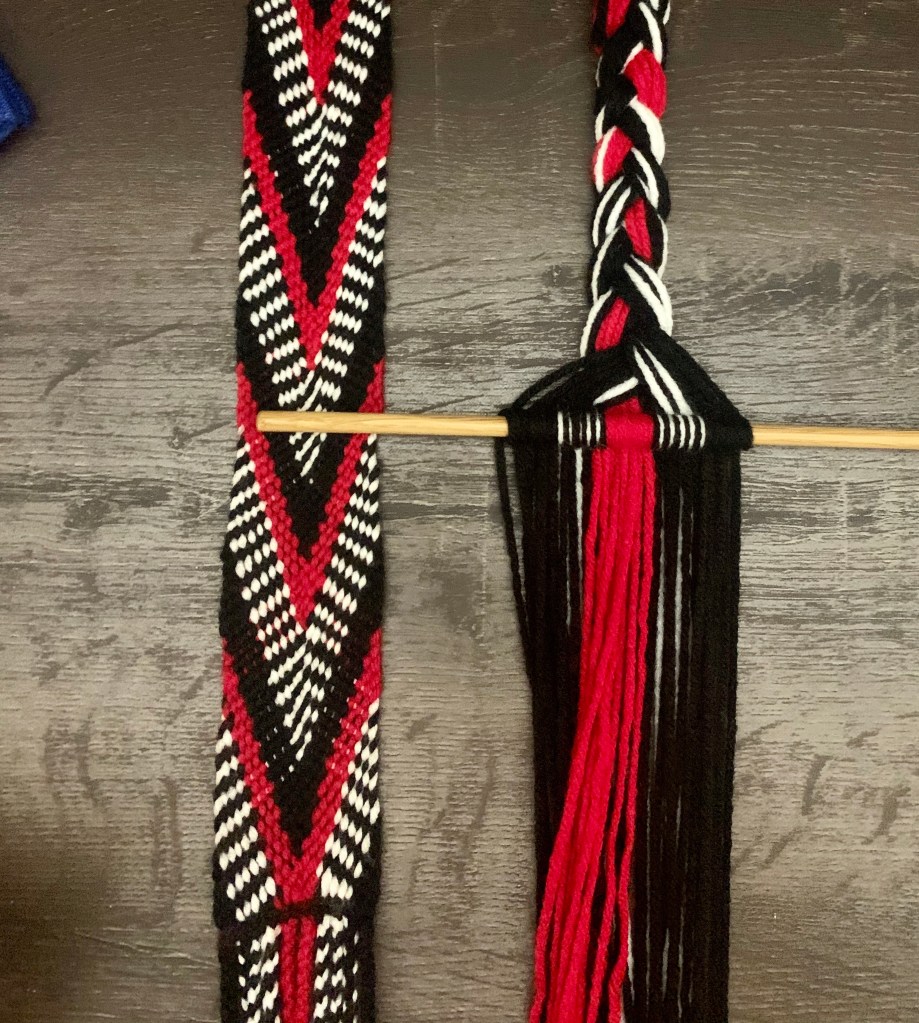

Joshua: How has your view of yourself as a weaver changed during your time interacting with your community?
Jared: I think being a weaver has informed how I interact with the community and provided a way for me to give back. I think the biggest thing weaving has allowed me to practice, is what I call “indigeneity” and in a sense, what being a Myaamia person means to me. To give an example, when you start a textile project and learn how to process materials to turn into thread that you turn into the final product, you start looking at the places you live as being able to provide these materials which gives you a sense of how places take care of people. So, I think being a Myaamia person and being a weaver has allowed me to start connecting with our traditional ecology, and that informs how I fit in our community and how I practice Myaamia indigeneity.
Joshua: This kind of connects to what your graduate work is going to be, correct? Tell us a little bit about that.
Jared: So, I’m here at Miami University pursuing my Master’s in Environmental Science degree with a concentration in applied ecology and conservation. That concentration area is really looking at destructive relationships that have taken place in myaamionki (the lands of the Myaamiaki) through colonization and forced removal. We haven’t been in some of these places to maintain our ecological relationships, and so now we have environments with invasive species, and some of the plants and animals we have relationships with are no longer present. My work is hopefully to restore some of these relationships. One relationship that I am currently focused on is looking at bulrush, making sure that if we want to do cultural work with bullrush, if we want to start doing bulrush mats workshops, that we have bulrush present in Myaamia spaces. That might take some ecology and conservation work to make sure some of our tribal land acquisitions have bulrush reestablished and that we’ve done the work to know that those populations can support cultural use.
Joshua: Can you tell us a little bit about your experience and your time at Haskell, how did that sort of change your art and your view or your craft and your view as a weaver, of yourself even?
Jared: Haskell gave me an intertribal identity. It also forced me to come back to our community and ask questions about Myaamia practices because I had friends that were curious about what we do. I think Haskell informed my Myaamia identity just through comparison with my peers. It got me to be very in touch with how different communities see themselves, see their ecological relationships, and how that’s been reflected in some of the material culture they have — some of the textiles that they produce.
Joshua: How do you incorporate Myaamia imagery into your work?
Jared: It depends on what I’m working on. When I do fingerweaving, it’s not necessarily what I would consider iconographic. You’re not doing figure work. So, a lot of it is brought in through color combinations. If I want to be intentionally Myaamia, I might do a lot of red, black, and white work because all that contrast contributes to “shimmer”. But if we think of the idea of shimmer beyond just those colors, we can bring in other colors, and we certainly see other colors used historically, and that builds on the idea of shimmer.
When I make twined bags, there’s a lot more imagery directly connected with our Myaamia community. There is the intention of having both sides of the bag represent ciinkwia and lenipinšia, even if they’re just geometric representations. There’s this contrast between those two sides. Something I’m trying to do on the bag I’m currently working on is, I think, an important aspect of Myaamia aesthetics seen in the Peconge bag. The edges of the geometric shapes aren’t clearly defined. It could be really sharp, but the Peconge bag, I don’t know what to call it, but it has “feathered edges”. I think that is part of that shimmer aesthetic. There’s more visual tension between the items not being clearly defined. I think that’s part of its shimmer. The more you try to see the border between dark and the light, the more that it seems to be obstructed. I think that’s part of it.

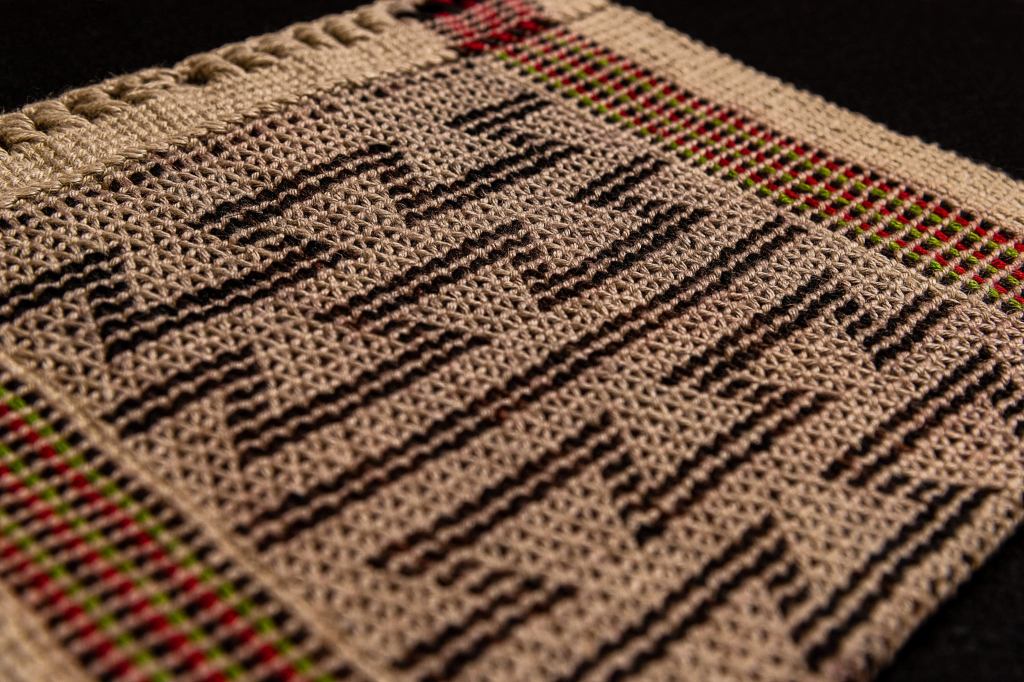
Joshua: Can you speak a little bit more about shimmer itself and where this idea came from?
Jared: My idea of “shimmer” comes from extensive cultural work that came before me. I’ll probably not get everybody in there, but Karen, Scott, George, Kara and everyone who helped in creating the ribbonwork book were thinking really intently about Myaamia aesthetics when examining ribbonwork pieces and coming up with how we think about a Myaamia aesthetics historically and today, and how that informs ribbonwork practices. One of those components was shimmer, and I’ve kind of internalized it as an aesthetic representation of power. The idea that power is kind of a glittering light. When you bring that idea into garments like ribbonwork, shimmer, is…I want to call it, like a visual dissonance. It’s hard to look directly at shimmer because it’s bright and has movement. The harder it is to look at, the more power. And so that idea in design, the busier or more dissonance there is in its aesthetic, the more amplified, the more it embodies that idea of shimmer. You have to look away because of it being so powerful. And so, trying to bring in that idea that your eye does not want to rest on a piece is something that I think is important. And so that’s where I think that idea applies to twined bags. Your eye does not want to rest on the edge of that image because it’s not clearly defined. When I do fingerweaving, I try to incorporate that as well.
Joshua: Is there anything else about the current pieces you’d like to talk about?
Jared: iihia, there’s been a top-down approach of how I’ve learned. Specifically the twined bag work that I’m in the middle of almost goes against how learning a bag traditionally would have been. I’ve started with commercial linen yarn, and that kind of embodies the idea of bast fiber bags. I’ve been learning or trying to replicate the techniques that I see first in order to start with making a bag. And then from that, working back to sourcing materials, to learning how to process, let’s say, basswood for the bag. And so those are the steps I’m working towards so that I can fully reconnect that circle of reciprocity between me taking care of a place and a place producing raw materials for me to turn into a bag. I am on a journey to reconnect all of that, and I’m not quite there. I just harvested some milkweed that I hope begins that journey of fully taking plant material to finished product. I think that is probably an important thing to talk about with revitalization, is deciding what place you’re going to start at. And for me, it’s learning how to create the object and then really figuring out what comes into play to make that piece. Sometimes it’s the other way around where you might learn how to process material and then take material to a final product. I guess that’s a future goal.
Joshua: My next question is about the future. So, this is perfect.
Jared: I think my identity as a weaver, and part of my journey as a weaver and what I’m working towards is the ability to, and what I guess is an extension of essentially body sovereignty, to clothe myself. The idea that currently within our nation, we’re outsourcing how we clothe ourselves and that a lot of the other material parts of our community come from external sources. A lot of times that has environmental consequences. So, re-learning how to do some of these things is with the idea that in the future I will have the skills and materials to be able to clothe myself. That’s something that I think is really important when evaluating the success of my life, what I’m really working towards, not just as a weaver. I think part of that is re-learning how to have that connectedness to place. And until I’ve reconnected, until I’ve reestablished how a place can take care of me, I don’t feel like I quite belong to that place. And so, I think part of that journey is with cloth and learning how to clothe myself.
Joshua: How do you see yourself or how do you see working with the Myaamia Center and participating with the Heritage Class as influencing your future craft?
Jared: So, I kind of hinted at this earlier that when I attended Haskell, it was very inter-tribal and discovering what it meant for me to be a Myaamia person in that inter-tribal context. Now that I’m attending Miami University, and I’m working with the Myaamia Center, and I’m around a Myaamia community almost daily, I’m starting to figure out what it means to be a Myaamia person in a Myaamia context. That has really been amazing, because I’m not only seeing how I fit in the community, but I’m seeing how the work everyone at the Center does contributes to community health and how we each play an important part in our community. So, I think it really makes me value people in our community. I think it also strengthens the relationships I have with those individuals. And it makes me really excited to do the work that I plan to do coming out of my Master’s program.
Joshua: Tell me a little bit about your thoughts about gifting and selling items and such.
Jared: I don’t know if it’s necessarily a Myaamia practice or something I developed from relationships I made at Haskell, but I found it really important that when I learned something new, the first thing I made with that knowledge was gifted. That’s something I do because I think it acknowledges the fact that I’m learning something, and that knowledge was a gift shared with me. So, continuing that idea of receiving a gift, there is reciprocity with gifting what you made from that exchange. So, most of the things I’ve made, if I’ve done something for the first time, whether it’s the first time I fingerwove or the first time I did a twine bag, those all were gifted to show the significance of what it meant for me to learn. I don’t know if that’s something the whole community can develop or should, but it’s something I found pretty important in my self-practice. As I continue to learn new things, I intend to continue that practice. I think it also helps me develop relationships. A lot of the things I’ve made, I’ve gifted or traded as a way to recognize relationships that I have in my life. So, I have a little bit of work to do to wrap my head around wanting to sell things I make, but one thing I think I will never sell are works where I processed the material myself and created the object from that. I think that the gift of being able to process and turn something from our environment, from one of our relatives in myaamionki, isn’t something to be profited off of. I think that’s something for us to continue that relationship building with, so I don’t think I will ever take a piece like that and turn around and sell it. I think the pieces, if I do that, will be commercial materials.
Joshua: iihia. So, you mentioned this piece over here, where is that going?
Jared: To the Indiana University Museum of Archaeology and Anthropology, their new museum. I need to get to work. That’ll be Thanksgiving break, I think I got like 40 hours left on it. I’m thinking it’s over 80 hours total of work. I don’t like thinking about how long something’s going to take me, and thinking of how much I should sell my work. That feels problematic to value my work in our community that way when it goes beyond making tangible products. But I had to do that for this bag, and I think it makes it less enjoyable to do when I’m counting down the hours or having to keep track. The things I typically make, I don’t keep track of how long it takes me because it’s just going to take as long as it takes. And it’s pretty meditative to do the work. I think it got me through the pandemic.
Something like this (points at a current piece, a sash). I don’t really know how long it’s taken me to do. I love doing this one more than I like doing that one. And it’s not that I like the technique more. It’s just because this will be one of the first items, I get to keep myself.

The thing that drives the museum project is knowing that we’re going to be represented in a museum with our textiles. And I think a big thing we face in our community as Great Lakes people, and something I had to unlearn myself, is the false idea that our only clothing was furs and we didn’t have textiles. We had a lot of techniques in our community and a lot of materials. Scott Shoemaker was really helpful in sending me examples of fingerwoven sashes and the Peconge bag, because I didn’t know we made things like that. When I first started my journey into Myaamia textiles and he sent me things, my reaction was, “oh my gosh, we did that”. We made bulrush mats, and we have some awesome textile techniques.
Joshua: I only have one last question, and it’s the big open ended one. What else do you want people to know about you and your craft, your weaving? Really the question is about if there is something we missed? It’s been a pretty wonderful interview. I appreciate you so much.
Jared: Practicing weaving not only connects you to culture, but it connects you to ecology. I think it’s a new lens to see the world, kind of like what I’ve mentioned, nature looks more like a shopping cart now. It’s also a lens to view a lot of historic events. So, the fact that most of history is tied in some way to textiles is, I think, a really interesting thing. Colonization was powered by woven sails and cotton played a big part in the displacement of tribes in the U.S. And it wasn’t just the US. I mean, India had the whole cotton-calico thing with their occupation by Britain. A whole lot of the world conflicts kind of come back to textiles. Textiles are cool and definitely shaped the world.
Visit the Aanchtaakia Graduate Fellowship webpage for more information about the program.


